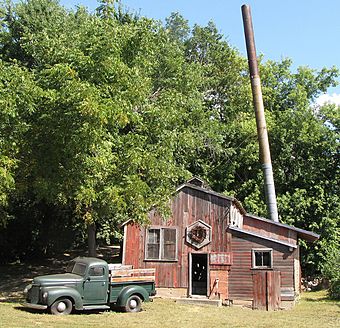Seha Sorghum Mill facts for kids
The Seha Sorghum Mill is an old building in Janesville Township, Minnesota. It was a special factory that made sweet sorghum syrup. This mill worked from about 1904 until 1956.
It is a very important historical site. In 1979, it was added to the National Register of Historic Places. This means it's a special place that tells us about farming, machines, and how people lived in Minnesota long ago. It's the only old sorghum syrup mill left in the state. Today, you can find the mill at the Okaman Elk Farm, which is a place people can visit.
What the Mill Looks Like
The Seha Sorghum Mill is located on a farm. It is about 1 mile (1.6 km) east of Elysian, Minnesota. The mill was built on a small hill. This was a clever design choice.
Building on a hill meant that gravity could help move the liquids. The sorghum juice would flow from one step to the next without needing pumps. This made the syrup-making process easier.
The oldest part of the building is in the northwest corner. It has the main door that faces west. There are also three small windows on the south side. You can see a special vent on the roof, which helped steam escape. Over time, more parts were added to the building. One important addition was a room for the steam engine and its tall chimney.
How the Mill Made Syrup
By the 1930s, the mill looked much like it does today. Making sorghum syrup was a multi-step process. First, tall sorghum stalks were brought into the mill.
They went onto a moving belt, called a conveyor belt. This belt carried the stalks to a special machine. This machine, called a roller mill, had three cylinders that crushed the stalks.
The juice from the crushed stalks flowed into three large tanks. These were called defecation tanks. Here, the juice was heated with steam. This heating helped to remove any unwanted bits or impurities.
After being cleaned, the juice moved into a long, shallow pan. This was called an evaporator trough. In this trough, the juice was boiled. Boiling made the water evaporate, turning the juice into thick, sweet syrup.
Once the syrup was ready, it went through a water cooler. This cooled the hot syrup down. Finally, the finished syrup was stored in three large wooden tanks. It stayed there until it was sold. This mill could make about 50 US gallons (190 L) of syrup every hour.
Powering the Mill
The mill needed power to run its machines. It used an old 16-horsepower steam engine. This engine was built way back in the 1860s in Mankato, Minnesota.
The steam engine did two main jobs. It powered the conveyor belt and the roller mill that crushed the stalks. It also made the steam needed to heat the juice in the tanks and the evaporator. A boiler, which was added later, created the steam. This boiler used coal or wood as fuel.
History of the Mill
Making sorghum syrup started in Minnesota around 1860. It became very popular in the 1880s. The southern-central part of Minnesota, including Waseca County, made most of the state's syrup. About three-quarters of all Minnesota's sorghum syrup came from this area.
Cornelius L. Seha built this permanent sorghum syrup mill on his farm. It was set up around 1904 or 1905. At first, the mill was just one room for the evaporator. The steam engine was outside.
In the 1930s, the Seha family made the building bigger. They built a room to cover the steam engine. They also added more machines to help with the syrup making. Most of these machines were bought used. The boiler, which made the steam, was added in the 1940s. The Seha Sorghum Mill stopped making syrup around 1955 or 1956.




